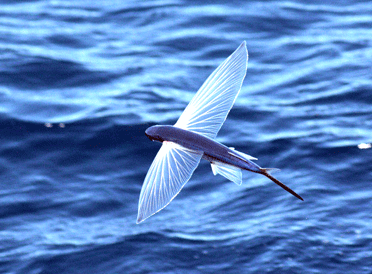
A six inch white and silver sliver rockets out of the water.
A bird? No, not with those incandescent wings…insect like.
It glides over the rollicking waves, unperturbed at the irregularity of the watery medium it has escaped. The flying fish is my new favorite creature. I have known about them for as long as I can remember, but have never seen them in life, not even on the North Atlantic. They come in several sizes. None of the big ones have ended up on deck but we get two to four small ones on deck every day. Up close they look like an elongated teardrop shape with over-sized wings that look like they were borrowed from a dragon fly. No matter the size, the amount of time they spend in the air boggles my mind – sometimes up to four hundred yards, and we have seen them climb to at least twenty feet. The ones that hit the deck are dead on impact. Since you can eat whole fish under 3-inches, I have taken to augmenting my diet with them. I’m up to three and plan to eat at least 100 by the time the row is over… yum!
[Want to know what other kinds of amazing creatures the ocean rowboat will see? See the creature page at YourWildAdventure.com]
So why do flying fish, well, fly?

Generally we’ve found that flying fish tend to be very active when there are other sea creatures around us – namely dolphins. We’ve been seeing lots of what we think are short-beaked common dolphins lately (you sometimes don’t even go a whole day without seeing at least one), and when it doesn’t look like they’re actually on their way somewhere, they’re probably feeding. Out of nowhere a flying fish will launch itself from the water, vigorously flapping its tale to remain airborne for anywhere from 50-150 feet to evade their predator. Then, splash! sploosh! and there goes another one headed another direction. On the North Atlantic, Dylan and Greg saw a literal school of smaller flying fish coming right toward them – a few actually passing right between from one side of the boat to the other.
Here’s some interesting background information about flying fish I grabbed from Wikipedia: “Flying fish live in all of the oceans, particularly in tropical and warm subtropical waters. Their most striking feature is their pectoral fins, which are unusually large, and enable the fish to hide and escape from predators by leaping out of the water and flying through air a few feet above the water’s surface. Their flights are typically around 50 meters (160 ft).

“To glide upward out of the water, a flying fish moves its tail up to 70 times per second. It then spreads its pectoral fins and tilts them slightly upward to provide lift. At the end of a glide, it folds its pectoral fins to reenter the sea, or drops its tail into the water to push against the water to lift itself for another glide, possibly changing direction. The curved profile of the “wing” is comparable to the aerodynamic shape of a bird wing. The fish is able to increase its time in the air by flying straight into or at an angle to the direction of updrafts created by a combination of air and ocean currents.
“Genus Exocoetus has one pair of fins and a streamlined body to optimize for speed, while Cypselurus has a flattened body and two pairs of fins which maximizes its time in the air. From 1900 to the 1930s, flying fish were studied as possible models used to develop airplanes.
“Exocoetidae feed mainly on plankton. Predators include dolphins, tuna, marlin, birds, squid and porpoise.”
